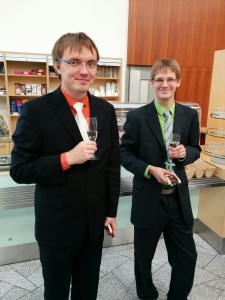 These very important (and up to now not completely solved) questions got a lot clearer on Aug 31, 2016 as PhD dissertations addressing these topics were defended at UT Institute of Chemistry.
These very important (and up to now not completely solved) questions got a lot clearer on Aug 31, 2016 as PhD dissertations addressing these topics were defended at UT Institute of Chemistry.
Asko Laaniste (left on the photo) in his thesis titled “Comparison and optimisation of novel mass spectrometry ionisation sources” and in the recent paper ESI outcompetes other ion sources in LC-MS trace analysis Anal. Bioanal. Chem. 2019 has carried out an extensive experimental comparison of 4 different LC-MS ion sources operated altogether in 7 different modes in the analysis of 41 different pesticides. The obtained large pool of data was used for comparing the sources in terms of matrix effects, limit of detection (LoD), repeatability, linearity, signal to noise ratio (S/N) and sensitivity.
Asko demonstrated that for low levels of analytes in most cases the conventional ESI is the ion source of choice (provided the analytes are ionizable with ESI), while dopant-assisted APPI is a good alternative if low detection limits are not required and if compounds not ionizable with ESI are determined.
This is currently the most comprehensive comparison of this type available and Asko’s thesis (and the forthcoming publication) could serve as a “desk manual“ for LC-MS practitioners on choosing ion source for LC-MS analysis.
The central question of Hanno Evard’s thesis “Estimating limit of detection for mass spectrometric analysis methods” and in the corresponding two-part tutorial review Tutorial on estimating the limit of detection using LC-MS analysis (Anal. Chim. Acta 2016, 942, 23-39, Anal. Chim. Acta 2016, 942, 40-49) was: what is the best way of evaluating detection limit (LoD) of an analytical method? There are around ten widespread approaches for LoD in the literature (plus less well known ones) and the LoD values obtained using different approaches can differ by up to 10 times.
Hanno (right on the photo) carried out comprehensive analysis of the literature approaches and combined that with extensive experiments. As a result he was able to propose and convincingly justify one approach, which has merits over others and should be used for evaluation of LoD.
Hanno Evard is an alumnus of the Applied Measurement Science programme – the predecessor programme of EACH.
Our warmest congratulations to Asko and Hanno!










